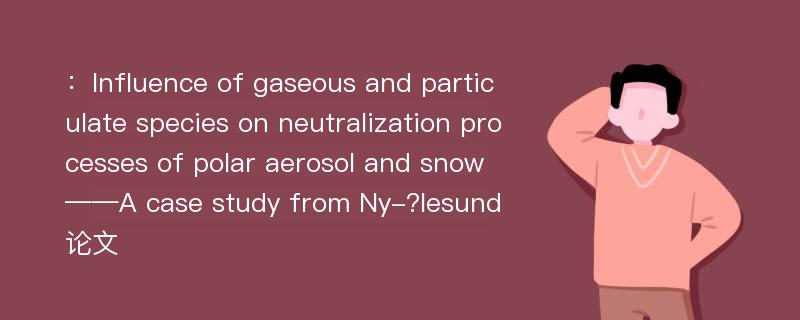
本文主要研究内容
作者(2019)在《Influence of gaseous and particulate species on neutralization processes of polar aerosol and snow——A case study from Ny-?lesund》一文中研究指出:The inter-conversion of nitrogen and sulfur species between the gas and particulate phases and their interaction with alkaline species influences the acidity of the aerosols and surface snow. To better understand these processes, a short field campaign was undertaken in Ny-?lesund,Svalbard, during 13th April 2012 to 24th April 2012. Air measurements were carried out through a particulate sampler equipped with denuders and filter packs for simultaneous collection of trace gases(HNO3, NO2, SO2 and reactive nitrogen compounds) and aerosols, with daily collection of snow samples. Ionic composition of the samples was analyzed using ion chromatography technique. The results suggested that nitrate-rich aerosols are formed when PAN(peroxy acetyl nitrate) disassociates to form NO2 and HNO3 which further hydrolyzes to form pNO3-(particulate nitrate). This resulted in a high contribution of pNO3-(62%) to the total nitrogen budget over the study area. The acidity of the aerosols and snow evaluated through cation/anion ratio(C/A)indicated alkaline conditions with C/A > 2. The bicarbonates/carbonates of Mg2+ played an important role in neutralization processes of surface snow while the role of NH3 was dominant in aerosol neutralization processes. Such neutralization processes can increase the aerosol hygroscopicity causing warming. Chloride depletion in the snow was significant as compared to the aerosols, indicating two important processes, scavenging of coarse sea salt by the snow and gaseous adsorption of SO2 on the snow surface. However, a more systematic and long term study is required for a better understanding of the neutralization processes and chemical interconversions.
Abstract
The inter-conversion of nitrogen and sulfur species between the gas and particulate phases and their interaction with alkaline species influences the acidity of the aerosols and surface snow. To better understand these processes, a short field campaign was undertaken in Ny-?lesund,Svalbard, during 13th April 2012 to 24th April 2012. Air measurements were carried out through a particulate sampler equipped with denuders and filter packs for simultaneous collection of trace gases(HNO3, NO2, SO2 and reactive nitrogen compounds) and aerosols, with daily collection of snow samples. Ionic composition of the samples was analyzed using ion chromatography technique. The results suggested that nitrate-rich aerosols are formed when PAN(peroxy acetyl nitrate) disassociates to form NO2 and HNO3 which further hydrolyzes to form pNO3-(particulate nitrate). This resulted in a high contribution of pNO3-(62%) to the total nitrogen budget over the study area. The acidity of the aerosols and snow evaluated through cation/anion ratio(C/A)indicated alkaline conditions with C/A > 2. The bicarbonates/carbonates of Mg2+ played an important role in neutralization processes of surface snow while the role of NH3 was dominant in aerosol neutralization processes. Such neutralization processes can increase the aerosol hygroscopicity causing warming. Chloride depletion in the snow was significant as compared to the aerosols, indicating two important processes, scavenging of coarse sea salt by the snow and gaseous adsorption of SO2 on the snow surface. However, a more systematic and long term study is required for a better understanding of the neutralization processes and chemical interconversions.
论文参考文献
论文详细介绍
论文作者分别是来自Journal of Environmental Sciences的,发表于刊物Journal of Environmental Sciences2019年02期论文,是一篇关于,Journal of Environmental Sciences2019年02期论文的文章。本文可供学术参考使用,各位学者可以免费参考阅读下载,文章观点不代表本站观点,资料来自Journal of Environmental Sciences2019年02期论文网站,若本站收录的文献无意侵犯了您的著作版权,请联系我们删除。
